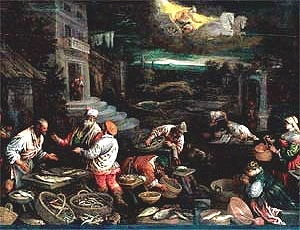Jacopo Bassano
Italian, c1510-1592 AN ALLEGORY OF FIRE, SN 86AN
ALLEGORY OF WATER, SN 87
From "The Pages"

|
|
 |
ARTIST:
The Bassanos were a family of painters. The grandfather, Francesco Bassano the Elder, was
an artist in the village of Bassano del Grappa. His son, Jacopo Bassano, was one of the
leading Venetian artists of the 16th century, who in turn had four painter sons
(Francesco, Leandro, Giambattista, Gerolamo).
Jacopo was apprenticed to, and later collaborated with, his father until the latter’s
death in 1539. He often visited Venice, where he studied Pordenone’s work, but lived
permanently in Bassano where he continued the family workshop. All his biographers praise
Jacopo for his humility; he led a secluded life in a small, provincial city, and declined
invitations to serve foreign princes. He maintained friendships with some of the most
important artists of his time: Tintoretto, Caracci, and Veronese. He was also an expert
musician and a keen reader, with a rigorous moral code, e.g. he wouldn’t paint scenes
that might arouse scandal. His interest in botany shows in the realistic flowers and
plants in his paintings.
He kept up with artistic trends, however, by studying a wide range of graphic materials,
alternating those with direct observation when he painted. He followed the Mannerist trend
for a time, influenced by Tuscan painters visiting Venice – Salviati and Giorgio
Vasari among them.
After 1562 he returned to a more relaxed classicism, inventing another type of
collectors’ picture – a medium-sized Biblical subject in a genre setting. From
1576 he did a series of night scenes, including our Allegories (which are mentioned in the
Dictionary of Art!). Jacopo continued active in his last 10 years, concentrating on
smaller religious pictures with highly dramatic lighting. On his death he left most of his
goods and the famous studio to his least-talented sons, Giambattista and Gerolamo; smaller
shares went to Francesco and Leandro because the latter 2 needed help the least.
SUBJECTS:
Representations of the four elements were popular in Renaissance art, and these two
paintings were part of a series. Such scenes, incorporating many figures and animals, were
a much appreciated specialty of the Bassano family workshop. Jacopo was probably assisted
by his son, Francesco, in the painting of these works.
In Allegory of Fire, the Greek god Vulcan, a blacksmith, works at his forge. His wife
Venus (in classical dress, seated at a table left) has asked Vulcan to forge armor for her
son. Near her, a winged child plays with an attentive dog. The metal pots, ewers, and pans
that Vulcan has produced earlier occupy the right foreground.
In Allegory of Water, Jacopo sets the scene in a contemporary fish market, against a
landscape of classical ruins. Overhead Neptune, the god of the sea, drives his chariot
across the sky.
PAINTINGS:
Night scenes present a particular challenge, as enough light sources must be included to
define the scene without completely destroying the effect of darkness. In the use of
concentrated light sources, these paintings anticipate the chiaroscuro for which
Caravaggio is famous in the Baroque period.
HISTORIC CONTEXT:
In this period, the elements were used not only to represent physical properties, but
human temperaments as well. Fire represented the choleric type, water the phlegmatic,
earth the melancholic, and air the sanguine.
As noted, Bassano worked not only in Bassano del Grappa, but in Venice as well. Known as
the “Pearl of the Adriatic,” Venice is a cluster of islands at the head of the
Adriatic Sea that was approachable only by
water until the middle of the nineteenth century, when a causeway was constructed. In the
15th century Venice expanded her territory into the mainland; these lands were called
Terraferma, and included the town of Bassano - a source of food supply for Venice. By the
end of the 15th century, trading activities and immigration to Venice had produced one of
the most heterogeneous populations in Europe.
Four significant circumstances made an impact upon the evolution of Venice: its singular
setting, its tenacious Byzantine heritage, success as a vast trading empire, and its
cohesive political and social structure that was cosmopolitan in character.
During the period of Counter Reformation in the 1500’s, the Council of Trent began,
the Inquisition was established, Ignatius Loyola founded the Jesuit order, Michelangelo
took over the rebuilding of Saint Peters, and Phillip II was the king of Spain and ruler
of Netherlands, Americas, Milan, Burgundy, Naples, and Sicily.
Museum Label:
An Allegory of Fire
16th century
Artist: Jacopo Bassano
Italian, c. 1510-1592, active in Venice and Bassano del Grappa
Oil on canvas, 55 x 71 5/8 in. (139.7 x 181.9 cm)
Representations of the four elements of Earth, Air, Fire and Water were popular in
Renaissance art. Here, Jacopo Bassano shows Fire set in a blacksmith's forge, while the
Greek god Hephaistos rides in his chariot above. The use of competing sources of
illumination from the forge and from the moon adds interest to the composition and
foreshadows similar strategies in the later art of Caravaggio.
Bequest of John Ringling, 1936, SN86
ringlingdocents.org
|